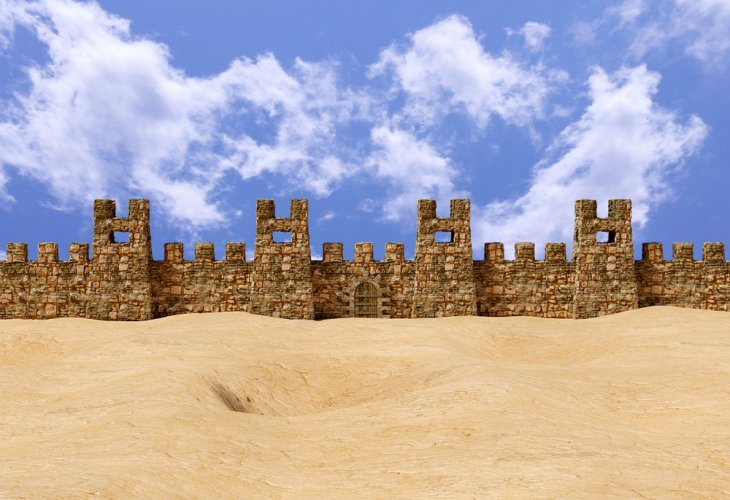Jericho's Fall: The Miracle and the Mystery
Why did Hashem choose to perform a miracle at Jericho? What was the ban placed by Joshua on the city, and is there a prohibition on living there today? Discover the captivating details.
 (Photo: shutterstock)
(Photo: shutterstock)Joshua son of Nun conquered Jericho during the Israelite conquest of the land. After seven days of the Israelites marching around the city, priests blew their shofars, and the walls collapsed. This great miracle has been remembered through generations.
Several expeditions have excavated Jericho: John Garstang’s team before World War II, and Kathleen Kenyon’s after the war. They uncovered fascinating findings. Jericho was possibly the first city structured in the Middle East, warranting Joshua’s focus and the great miracle that Hashem performed there to demonstrate His power to the nations.
Excavators even found a massive wall that collapsed, possibly due to an earthquake, as Kenyon speculated. However, they faced a challenge: they didn’t find remnants from the Late Bronze Age, the time of the Israelite conquest. The story is compelling and fits the narrative of the fallen wall, but not its timeline...
Over thirty years later, Bryant Wood revisited this question by reviewing the excavation reports. It turns out the city's dating was based on Cypriot imports. Archaeological dating methods are diverse and intriguing, involving Cypriot pottery produced precisely during the Late Bronze Age, commonly found in cities of that era.
The catch, Wood noted, was that Kenyon excavated only a very small section of Jericho—specifically, two squares each measuring 26 feet by 26 feet. Archaeological digs require years and significant funding, needing a team to meticulously excavate, document, and analyze every artifact. Hence, entire cities are not excavated, but specific spots are chosen.
Apparently, Kenyon selected Jericho’s poor district, where imported vessels were unlikely to be found. Purchasing glassware transported by ship from Cyprus and then by camel caravan to Jericho required substantial wealth, something the poor district lacked, although wealthy governors and officials were present elsewhere.
Thus, we shouldn’t be hasty in drawing conclusions. The story in the Book of Joshua is the truth, and doesn’t need Ms. Kenyon’s validation. Another intriguing detail is the biblical description of Rahab: “She lived in the wall.” Indeed, Jericho’s ancient wall had houses integrated within it. Rahab could reside within the wall, her window overlooking the city’s outskirts, from where she lowered the spies sent by Joshua.
Joshua put Jericho under a ban, burned its spoils, and issued a severe curse on anyone who would enjoy them. Achan son of Zerah violated this ban, leading to his execution, and Joshua declared: "Cursed be the man who rebuilds Jericho! At the cost of his firstborn he will lay its foundation; at the cost of his youngest, he will set up its gates!"
Indeed, Hiel the Bethelite, during the times of the wicked King Ahab, decided to test this by relying on Baal rather than the God of Israel. When he began building Jericho's foundation, his eldest son died. Did Hiel admit his mistake? No, with great arrogance, he dismissed it as coincidence, ignoring his youngest’s pleas. As the workers set up the gates, his youngest son died! The wicked do not repent, even at the brink of disaster.
However, after the city was rebuilt, Joshua’s ban was lifted. The villain received his punishment, and there’s no prohibition on living there, since the construction dissolved the ban. Despite this, an interesting tale from the Second Temple period exists. John Hyrcanus, a notable figure in Jewish leadership, built a large fortress in Jericho, which had remained desolate since the fall of the Israelite Kingdom. Although John was a righteous leader, he eventually turned Sadducee, prompting sages to caution: "Do not trust yourself until your dying day."
A text found in the Dead Sea Scrolls, numbered 4Q175, says: "When Joshua finished and praised and thanked with psalms, he said, 'Cursed be the man who rebuilds this city. With his firstborn, he will lay its foundation, and with his youngest, he will set up its gates.' And cursed was the wicked man who ensnared his people, bringing ruin to his neighbors, setting his two sons to continue as instruments of violence, to rebuild this city and construct its walls and towers..."
The scroll’s continuation is missing, but it seems the author condemns the leader for entrusting his two sons with the fort in Jericho, alleging he broke Joshua’s curse.
Indeed, John’s sons, Aristobulus and Antigonus, died young, possibly reinforcing this belief, and perhaps it appeared in the scroll’s continuation...
Nevertheless, Jewish sages didn't accept that living in Jericho is forbidden in our time, as after Hiel's malevolent act of lifting the ban and rebuilding the city, the curse focused on him alone and no longer applies to others.

